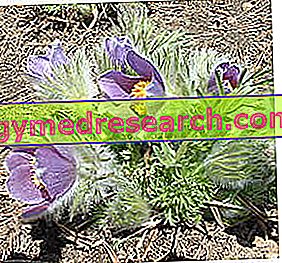Devil's grass
Pulsatilla, or devil's herb, a plant as treacherous as it is extraordinary: we are talking about a very special herb, whose pharmacological studies - actually reliable - started only towards the end of the twentieth century. If pulsatilla, on the one hand, seems miraculous for some disorders, on the other hand its immoderate use can trigger a series of very serious side effects, such as cardiac and respiratory disorders.
The plant, widely used in the homeopathic field, is particularly indicated in depressive states, and also useful in cases of insomnia, gastric problems, phlegm, fever and cystitis.
Botanical analysis
The genus Pulsatilla includes about 30 species of perennial herbaceous plants, belonging to the Ranuncolaceae family, very much

We emphasize the probably most important species of the genus Pulsatilla: P. vulgaris . The plant in question, perennial and herbaceous, can reach 20 centimeters in height and consists of villous and clearly divided leaves, pinnate and petiolate. The flowers are solitary, lilac and fragile. The rhizome penetrates deeply into the soil. [taken from Dizionario ragionato of herbal medicine and phytotherapy, di. Bruni]
Main properties
Pulsatilla is very rich in anemonine, an alkaloid responsible for the yellow coloring of the essential extract. The liquid characterized by anemonine is extremely volatile, burning and very irritating to the ocular and nasal mucous membranes: it is this molecule that attributes the antispasmodic properties to pulsatilla and therefore makes it useful in the treatment of digestive spasms, spasmodic cough and female genital pains.
Pulsatilla is useful for lightening migraine and neuralgia: the anti-migraine and anti-neuralgic virtues seem to be directly related to the action of anemonine.
But the extraordinary power of this pulsatilla marker goes much further: in fact, it appears to be an excellent natural analgesic for menstrual pain. More specifically, the pulsatilla creates analgesia in the case of dysmenorrhoea due to annexitis and ovaritis. Particular attention must be paid to menstrual pain associated with hypermenorrhea: in fact, pulsatilla treatment tends to increase menstrual flow, and in such situations it is not recommended to take it.
Man can also benefit from pulsatilla: disorders caused by orchitis, orchi-epididymitis and urethritis seem to weaken following the homeopathic intake of pulsatilla.
In the past, it was customary to exploit the medicinal virtues of the pulsatilla also to treat phlegm (expectorant properties) and to lighten states of anxiety and restlessness (sedative virtue). [taken from the Dictionary of herbal medicine and medicinal plants, second edition, by Enrica Capanini]
Additional properties
Although anemonine is the main cause of the therapeutic properties of the pulsatilla, protoanemonine must also be mentioned: this last molecule was exploited for its antibacterial, antifungal and blistering capacities. Precisely for this reason, it is necessary to pay close attention to the use of the plant. Pulsatilla extract is highly irritating: in this regard, it must be carefully diluted for oral administration, as well as for topical application.
Undesirable effects of the pulsatilla
So far we have listed and analyzed the therapeutic aspects associated with pulsatilla, leaving aside those that are toxic or otherwise dangerous. As mentioned in the introduction, the plant with its beautiful lilac flowers conceals dangerous aspects, sometimes serious ones.
Excessive doses of pulsatilla extract may cause vomiting, diarrhea, gastroenteritis, hematuria (blood in the urine) and albuminuria (high concentration of albumins in the urine). Overcoming the prescribed dosage, the intake of pulsatilla could generate even more serious disorders, up to create alarming situations, cardiac deficits and respiratory disorders.
In pregnancy, the intake of pulsatilla is prohibited due to the possible teratogenic effect: in grazing animals, in fact, abortions and teratogenic effects have been observed following the intake of plants with protoanemonine, including pulsatilla.
Summary
Pulsatilla: TO FIX THE CONCEPTS
| Pulsatilla | Popular synonym: devil's herb, improperly called anemone Botanical name: Pulsatilla vulgaris and P. pratensis | ||
| Pulsatilla as an object of study | Pharmacological studies that are actually reliable → started only towards the end of the twentieth century | ||
| Pulsatilla: fields of application | Phytotherapy, homeopathy | ||
| Pulsatilla: botanical description | Genus Pulsatilla: includes about 30 different species Most known species: P. vulgaris P. chinensis: Chinese anemone → intestinal disinfectant and antipyretic Family: Ranuncolaceae Pulsatilla general description: perennial and herbaceous plant, it can reach 20 centimeters in height Flowers: solitary, lilac and fragile Leaves: villous and clearly divided, pinnate and petiolate Rhizome: digs deep into the ground | ||
| Pulsatilla: anemonine | Alkaloid responsible for the yellow coloring of the essential extract
| ||
| Pulsatilla: protoanemonine | Molecule exploited for its antibacterial, antifungal and blistering capabilities | ||
| Pulsatilla and anemonina: properties | Pulsatilla is potentially useful in case of:
| ||
| Pulsatilla: contraindications | Not recommended in case of hypermenorrhea because taking pulsatilla tends to increase menstrual flow | ||
| Pulsatilla: side effects | Excessive intake of pulsatilla extract → vomiting, diarrhea, gastroenteritis, hematuria and albuminuria In the event of severity → creation of alarming situations, such as cardiac deficits and respiratory disorders | ||
| Pulsatilla and pregnancy | Pulsatilla intake is prohibited due to its possible teratogenic effect
| ||



